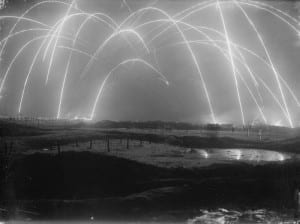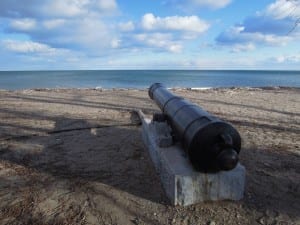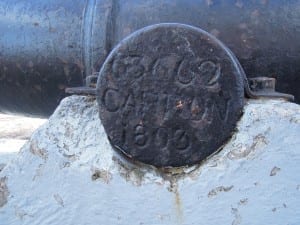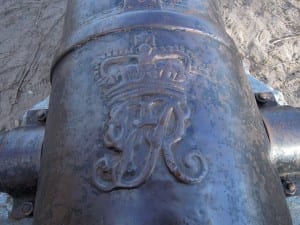The retired heavy gun on the beach at Marie Curtis Park was earlier located at Riverdale Park
We owe thanks to Malcolm Archer of Long Branch for bringing our attention to the August 2005 issue of The Fife and Drum, the newsletter of the Friends of Fort York and Garrison Common:
The Fife and Drum newsletter, August 2005 (includes article on of heavy guns)

Trench Warfare. Photo taken by an official British photographer during WWI, 1917. Source: History In Pictures @HistoryInPics. The photo assists in placing the history of cannons and artillery into a context that helps us understand the reality of warfare.
Ken Purvis refers in the article to heavy guns, such as the long gun located at Marie Curtis Park, as “a quintessential symbol of Canada’s colonial past.”
He also refers to the Motto of Britain’s Royal Artillery. The motto is ‘Ubique’, the Latin term for “Everywhere.”
After years of action, a cannon’s barrel would be reduced in thickness, making it potentially dangerous to a gun crew. In their retirement phase, such guns would occasionally end up mounted on plinths (bases) in parks.
The cannon, said to be a 32-pounder, at Marie Curtis Park was one of five retired heavy guns that had been sent to Riverdale Park, a park on the Lower Don River, after a Toronto alderman had in 1881 requested some cannons to decorate the park. The person who had granted the request was A.P. Caron, Minister of Militia and Defence, who had visited Toronto in that year.
The cannons had been transported from Quebec City. One of the heavy guns, manufactured by the Carron Company of Falkirk, Scotland, eventually found its way to Marie Curtis Park.
Updates
Our May 2013 Jane’s Walk included a visit to the retired heavy gun.
An additional photo of the cannon during the May 2013 Jane’s Walk in Long Branch can be found here.
Posts that serve to place advances in military technology into a context include these ones:
Technological advancement is a key storyline in the world history of warfare
Military history mural at Small Arms Ltd. building in Mississauga




thanks.
I learned to swim there as a little girl . ( dog paddle) My mother walked us down to the beach from our home on Villa Road.
Always wondered how the cannon became a part of the park .
Sandy Bray
I’m really pleased to know of how your mother used to walk you down to the beach from your home on Villa Road. I can picture it – warm summer days, the opportunity to learn to swim. I’m really pleased you’ve shared that memory with us.
I’m really pleased as well that Malcolm Archer, who has lived on Lake Promenade for some years, told us about the article in the newsletter of the Friends of Fort York and Garrison Common. That’s how I learned about the history of the cannon. I first met Malcolm when I made a presentation (the one that’s posted as an online video at Vimeo.com) a few years ago at the Long Branch Library about the history of the Colonel Samuel Smith homestead site.
July 23, 2020
Etobicoke
Marie Curtis Park.
I saw the cannon and was curious to how it got there. Why is there no plaque with its history? As someone who treasures history and feel that we should leave a trail of explanation for future generations I honestly believe a plaque should be beside that canon.
Cheers
Yvonne Penney
That’s a good question, Yvonne. I don’t know the answer. I do know that Heritage Toronto has a plaques program which encourages residents to apply for plaques. I would recommend that you contact Heritage Toronto, and perhaps also the Long Branch Neighbourhood Association, to see if it’s possible to have a plaque installed by the cannon at Marie Curtis Park.
In Stratford, where I now live, the Stratford-Perth Branch of Architectural Conservancy Ontario has a plaques program which provides plaques for historical buildings, of which there are many, in Stratford. It’s a great program — a great way to celebrate local heritage; the chapter’s website lists the heritage properties that have plaques and provides details.
What matters above all is the initiative of residents; residents play a key role in getting things such as plaque programs into place, in communities across Ontario.